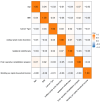Regression analysis and validation of risk factors for upper limb dysfunction following modified radical mastectomy for breast cancer patients
- PMID: 40385071
- PMCID: PMC12082522
- DOI: 10.62347/CZYA6232
Regression analysis and validation of risk factors for upper limb dysfunction following modified radical mastectomy for breast cancer patients
Abstract
Objective: To develop and validate a predictive tool using machine learning models for identifying risk factors for upper limb dysfunction following modified radical mastectomy (MRM) in breast cancer patients.
Methods: A total of 768 breast cancer patients who underwent Modified radical mastectomy (MRM) between January 2022 and December 2023 were included in this study. The dataset was divided into a training set (506 cases) and a validation set (262 cases). The collected data encompassed demographic characteristics, clinicopathological features, medical history, and postoperative rehabilitation plans. Predictive analyses were conducted using machine learning models, including support vector machine (SVM), extreme gradient boosting (XGBOOST), Gaussian naïve Bayes (GNB), adaptive boosting (ADABOOST), and random forest. Model evaluation was performed using ten-fold cross-validation, with performance metrics including receiver operating characteristic (ROC) curves, area under the curve (AUC) values, specificity, sensitivity, accuracy, and F1-score. DeLong's test was used to compare AUC values and identify the optimal predictive model.
Results: Baseline characteristics showed no significant differences between the training and validation sets (P>0.05). Analysis of factors associated with upper limb dysfunction in the training set revealed significant differences in variables such as age, BMI, cancer type, axillary lymph node dissection, ipsilateral radiotherapy, postoperative rehabilitation plans, and monthly per capita household income (P<0.05). Low correlations were observed among these variables (R values close to 0), indicating minimal multicollinearity. Model performance evaluation showed that the XGBOOST and random forest models demonstrated high AUC values (0.817-0.884) across both the training and validation sets. These models also exhibited superior specificity and sensitivity, indicating strong predictive performance and robustness in identifying patients at risk of postoperative upper limb dysfunction.
Conclusion: The XGBOOST and random forest models exhibited excellent predictive accuracy, offering valuable tools for the early identification and personalized management of high-risk patients. These models provide critical data support for postoperative rehabilitation planning and contribute to improving the quality of life for breast cancer patients.
Keywords: Modified radical mastectomy; XGBOOST; machine learning models; risk prediction; upper limb dysfunction.
AJTR Copyright © 2025.
Conflict of interest statement
None.
Figures




Similar articles
-
Predictive modeling of breast cancer-related lymphedema using machine learning algorithms.Gland Surg. 2024 Dec 31;13(12):2243-2252. doi: 10.21037/gs-24-252. Epub 2024 Dec 27. Gland Surg. 2024. PMID: 39822356 Free PMC article.
-
Ten-Year Multicenter Retrospective Study Utilizing Machine Learning Algorithms to Identify Patients at High Risk of Venous Thromboembolism After Radical Gastrectomy.Int J Gen Med. 2023 May 18;16:1909-1925. doi: 10.2147/IJGM.S408770. eCollection 2023. Int J Gen Med. 2023. PMID: 37228741 Free PMC article.
-
Development and validation of a prediction model for coronary heart disease risk in depressed patients aged 20 years and older using machine learning algorithms.Front Cardiovasc Med. 2025 Jan 9;11:1504957. doi: 10.3389/fcvm.2024.1504957. eCollection 2024. Front Cardiovasc Med. 2025. PMID: 39850379 Free PMC article.
-
Establishment and validation of a heart failure risk prediction model for elderly patients after coronary rotational atherectomy based on machine learning.PeerJ. 2024 Jan 31;12:e16867. doi: 10.7717/peerj.16867. eCollection 2024. PeerJ. 2024. PMID: 38313005 Free PMC article. Clinical Trial.
-
A Machine-Learning Model Based on Clinical Features for the Prediction of Severe Dysphagia After Ischemic Stroke.Int J Gen Med. 2024 Nov 28;17:5623-5631. doi: 10.2147/IJGM.S484237. eCollection 2024. Int J Gen Med. 2024. PMID: 39624613 Free PMC article.
References
-
- Bray F, Laversanne M, Sung H, Ferlay J, Siegel RL, Soerjomataram I, Jemal A. Global cancer statistics 2022: GLOBOCAN estimates of incidence and mortality worldwide for 36 cancers in 185 countries. CA Cancer J Clin. 2024;74:229–263. - PubMed
-
- Giaquinto AN, Sung H, Newman LA, Freedman RA, Smith RA, Star J, Jemal A, Siegel RL. Breast cancer statistics 2024. CA Cancer J Clin. 2024;74:477–495. - PubMed
-
- US Preventive Services Task Force. Screening for breast cancer. JAMA. 2024;331:1973–1974. - PubMed
-
- Sandoval JL, Franzoi MA, di Meglio A, Ferreira AR, Viansone A, André F, Martin AL, Everhard S, Jouannaud C, Fournier M, Rouanet P, Vanlemmens L, Dhaini-Merimeche A, Sauterey B, Cottu P, Levy C, Stringhini S, Guessous I, Vaz-Luis I, Menvielle G. Magnitude and temporal variations of socioeconomic inequalities in the quality of life after early breast cancer: results from the multicentric French CANTO cohort. J. Clin. Oncol. 2024;42:2908–2917. - PMC - PubMed
-
- Aitken GL, Correa G, Samuels S, Gannon CJ, Llaguna OH. Assessment of textbook oncologic outcomes following modified radical mastectomy for breast cancer. J Surg Res. 2022;277:17–26. - PubMed
LinkOut - more resources
Full Text Sources
